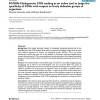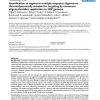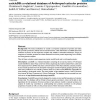BMCBI
2004
13 years 4 months ago
2004
Background: Recent genomic and bioinformatic advances have motivated the development of numerous network models intending to describe graphs of biological, technological, and soci...
BMCBI
2004
13 years 4 months ago
2004
Background: Genomic islands can be observed in many microbial genomes. These stretches of DNA have a conspicuous composition with regard to sequence or encoded functions. Genomic ...
BMCBI
2004
13 years 4 months ago
2004
Background: Kernel-based learning algorithms are among the most advanced machine learning methods and have been successfully applied to a variety of sequence classification tasks ...
BMCBI
2004
13 years 4 months ago
2004
Background: The rapidly increasing number of completely sequenced genomes led to the establishment of the COG-database which, based on sequence homologies, assigns similar protein...
BMCBI
2004
13 years 4 months ago
2004
Background: Computer programs for the generation of multiple sequence alignments such as "Clustal W" allow detection of regions that are most conserved among many sequen...
BMCBI
2004
13 years 4 months ago
2004
Background: Microarray data must be normalized because they suffer from multiple biases. We have identified a source of spatial experimental variability that significantly affects...
BMCBI
2004
13 years 4 months ago
2004
Background: A key step in the analysis of microarray expression profiling data is the identification of genes that display statistically significant changes in expression signals ...
BMCBI
2004
13 years 4 months ago
2004
Background: The function of a novel gene product is typically predicted by transitive assignment of annotation from similar sequences. We describe a novel method, GOtcha, for pred...
BMCBI
2004
13 years 4 months ago
2004
Background: Many current gene prediction methods use only one model to represent proteincoding regions in a genome, and so are less likely to predict the location of genes that ha...
BMCBI
2004
13 years 4 months ago
2004
Background: The insect exoskeleton or cuticle is a bi-partite composite of proteins and chitin that provides protective, skeletal and structural functions. Little information is a...



